How external benchmarking may be placing your ACFI funding at risk
Meaningless comparisons that cause missed funding and validation risk.
The Aged Care Funding Instrument (ACFI) provides funding for Residential Aged Care Facilities (RACFs) on a resident-by-resident basis. Based upon the clinical needs of each individual resident, the amount is given as a daily rate with 72 different funding options available.
Some aged care facilities compare their Average Daily Bed Rate (ADBR) against an external figure. This revenue measure, however, is meaningless unless it is known what it is actually reflecting. Additionally, reliance on this benchmark can cause complacency, inaccurate funding, and risk of losing funding at validation:
Obtaining the correct funding no longer becomes a priority. “We’re doing pretty good with ACFI; my vitals show that we’re $3/day better than average”. Comments like this should cause alarm bells to start ringing. This was a comment from a site where $206,000 in additional funding was found in less than one day for care that was already being provided, although this facility was doing well when compared to the national average, they were not receiving all of the funding they were eligible for.
It must be remembered that is the care needs of the residents in a facility are above average, then staff costs will be proportionally higher. So even if a facility’s revenue is above average, and motivation for change is limited, expenses will also be higher. This attitude limits profitability and ultimately long-term sustainability.
Arbitrary targets cause a culture of risk taking. If a facility is receiving all of the funding it’s eligible for based on each of the residents’ care needs, then ultimately it’s the type of residents who are in the facility that limits a facility’s funding. So what happens if the person completing ACFI submissions isn’t the same person who’s controlling the admission process?
Setting a Key Performance Indicator (KPI) based on daily bed rates (e.g. $165/day) is setting a goal for them that they cannot control. Unless they take risks. Comments like “I only need one more point to get them to the next category” are a big red flag that an organisation has a problem; staff are trying to look for ways to create increases that aren’t there, as opposed to lodging claims that reflect the residents’ care needs.
Benchmarking between sites within the same organisation is just as dangerous. If an organisation has a clearly identified market position, has differentiated itself in terms of the residents it attracts, and has a consistent capital strategy then benchmarking within the same organisation should work shouldn’t it? The short answer is “No”. Residents’ care needs change. When a resident departs, they’re often not replaced with one with the same clinical profile.
Working with one organisation recently, their lowest funded facility was the one with the best ACFI performance (despite getting the most heat from their Chief Financial Officer). Their ACFI funding was limited by the types of residents in their facility at that point in time. On the other hand, the facility with the highest number of HHH claims (over 60%) was the one where the most eligible funding was found.
Only once a facility is confident that they are receiving all of the funding they’re eligible for based on every single one of their residents’ care needs, can the average daily bed rate be used as a correlate to monitor the average resident profile of the facility.
To assist aged care organisations to achieve reach this space, HCA Online Learning have developed 12 ACFI Courses written by ACFI Experts for ACFI Coordinators and associated staff to reinforce the ACFI Guidelines and tweak their practices as needed to reach your goals. If your ACFI Team have not participated in additional external ACFI Training for a while, this is an economical educational tool which will test their current practices, and reinforce good process, whilst not being a burden to the learner.
